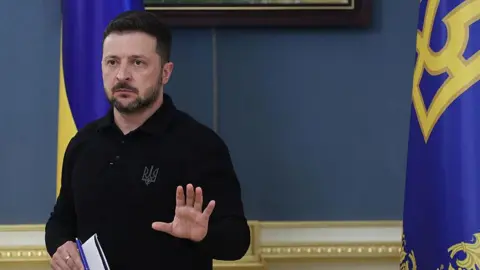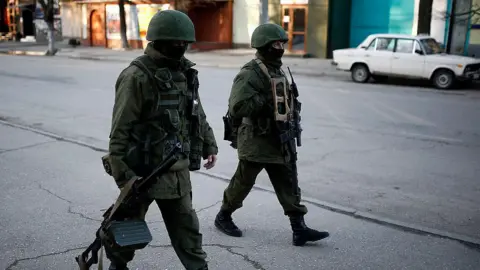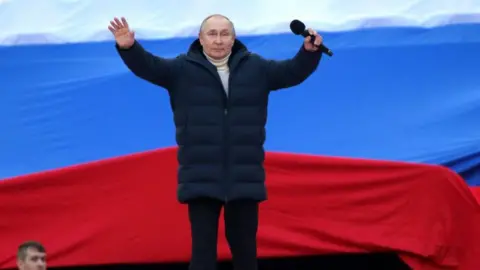NewsBeat
Why Zelensky can’t and won’t give up Crimea

Europe digital editor
 Getty Images
Getty ImagesVladimir Putin initially denied having anything to do with Russia’s capture of Crimea in February 2014, when mysterious masked commandos in unidentified green uniforms seized the local parliament and fanned out across the peninsula.
Those “little green men” marked the start of Russia’s war on Ukraine, which culminated in the 2022 full-scale invasion.
The future of Crimea is now at the centre of President Donald Trump’s peace plan and has prompted Ukraine’s Volodymyr Zelensky to rule out recognising Russian control of the peninsula.
The exact terms of his plan have not been published, but reports suggest it would include the US recognising Crimea as a legal part of Russia – de jure in Latin.
For Trump, Ukraine’s southern peninsula was “lost years ago” and “is not even a part of discussion” in peace talks.
But for Zelensky to renounce Crimea as an indivisible part of Ukraine would be unconscionable.
In the words of opposition MP Iryna Gerashchenko “territorial integrity and sovereignty is a red line for Ukraine and Ukrainians”.
Trump made the point that “if [Volodymyr Zelensky] wants Crimea, why didn’t they fight for it 11 years ago when it was handed over to Russia without a shot being fired?”
Few shots were fired, but Crimea was seized at gunpoint during a power vacuum.
Putin later admitted hatching the land-grab in an all-night meeting with his officials days after Ukraine’s pro-Russian leader was ousted in Kyiv.
 Getty Images
Getty ImagesCrimea a stumbling block for Trump
For a US leader in a hurry to secure a peace deal, Crimea could become a big stumbling block.
Trump is correct that there is little chance of Ukraine regaining Crimea in the foreseeable future, and it is in reality – de facto – under Russian control. But that is a far cry from recognising it as legal.
Zelensky points to a 2018 “Crimea declaration” by Trump’s then secretary of state, Mike Pompeo.
Pompeo said the US rejected “Russia’s attempted annexation of Crimea” and pledged to continue until Ukraine’s territorial integrity was restored.
Zelensky’s implication is that Trump backed Ukraine on Crimea then, and should stick to that now.
If a landgrab unrecognised by the international community is approved by the US as legal, what would that mean for international law and the principles of the UN charter?
Weeks after Russia’s full-scale war began, there was an initial proposal in Istanbul to park the issue so that Russia and Ukraine would aim to resolve it in the next 10-15 years.
The idea did not take hold but it was a way of getting over that stumbling block.
Zelensky constrained by Ukrainian constitution
 Getty Images
Getty ImagesZelensky was adamant that he has no power to give up Crimea: “There’s nothing to talk about here. This is against our constitution.”
Article 2 of the constitution states that Ukraine’s sovereignty “extends throughout its entire territory” which “within its present border is indivisible and inviolable”.
Any change to Ukraine’s territory has to go to a national referendum, which must be authorised by the Ukrainian parliament.
It is not just President Trump that has problems with Kyiv. Russia also sees the Ukrainian constitution as an “obstacle” to peace efforts.
Constitutions can be changed, but not while Ukraine is under martial law.
Approving Russia’s illegal annexation would not just be a red line for Ukraine but would be a terrifying precedent for countries such as Romania that border the Black Sea. The precedent would be felt far beyond the Black Sea.
Does Russia have a claim to Crimea?
 Getty Images
Getty ImagesFor historical reasons, Russians have long seen Crimea as part of their territory and Putin has spoken of a “living and unbreakable bond” with the peninsula, with its Black Sea resorts and balmy summer climate.
But Crimea along with the rest of Ukraine voted for independence from the collapsing Soviet Union in 1991 and Kyiv allowed Russia to lease the port of Sevastopol as a base for the Black Sea Fleet.
After its annexation in 2014 Putin sought to cement Russia’s control over Crimea, first with a 12-mile bridge built over the Kerch Strait in 2018 and then by capturing a land bridge along the Sea of Azov coast in 2022.
Putin felt he was righting a wrong inflicted on Russia when Soviet leader Nikita Khrushchev transferred Crimea to Ukraine in 1954. Russia, he said, was “not simply robbed, it was plundered”.
Crimea was first annexed by Tsarist Russia under Catherine the Great in 1783 and largely remained part of Russia until Khrushchev’s decision.
Russia and Ukraine were both Soviet republics so it was not a big deal for the Kremlin in 1954.
More than half the population of Crimea was Russian, largely because the original majority population of Crimean Tatars were deported under the Soviet dictator Stalin in 1944.
Tatars were only able to return to Crimea from exile from 1989 as the Soviet Union fell apart, and they now make up about 15% of Crimea’s population.
Russia quickly organised a referendum in March 2014 but it was rejected as a sham by the international community and the UN General Assembly adopted a resolution backing Ukrainian sovereignty.
The International Criminal Court ruled that Russia’s activity in Crimea amounted to “ongoing occupation”.
Refat Chubarov, Chairman of the Mejlis, a body representing Crimean Tatars, has insisted that Ukraine must categorically reject any territorial concession in exchange for peace.
“Crimea is the homeland of the indigenous Crimean Tatar people and an integral part of Ukraine,” he said.
Crimea may not be only problem
Trump’s peace plan has not yet been published, but according to various reports and remarks by US officials, Ukraine would be required to adhere to other difficult conditions.
Russia’s occupation of almost 20% of Ukraine would be de facto recognised behind existing front lines, in effect freezing the conflict in four Ukrainian regions: Donetsk, Luhansk, Kherson and Zaporizhzhia.
That would be backed up by a “robust security guarantee”, according to US outlet Axios, presumably backed up by a “coalition of the willing” involving the UK, France but not the US.
There would be a promise not to admit Ukraine into Nato, although it could join the EU.
All US sanctions would be lifted and economic co-operation with the US enhanced.
Axios also suggests Russia would return a small area of occupied Kharkiv and allow Ukraine “unimpeded passage” on the Dnieper river, while the US would take charge of the nuclear power plant in Zaporizhzhia, seized by Russia in 2022.
And then there is a US-Ukraine deal to share minerals profits, which Ukrainian Prime Minister Denys Shmyhal is expected to seal with the US by Saturday.

